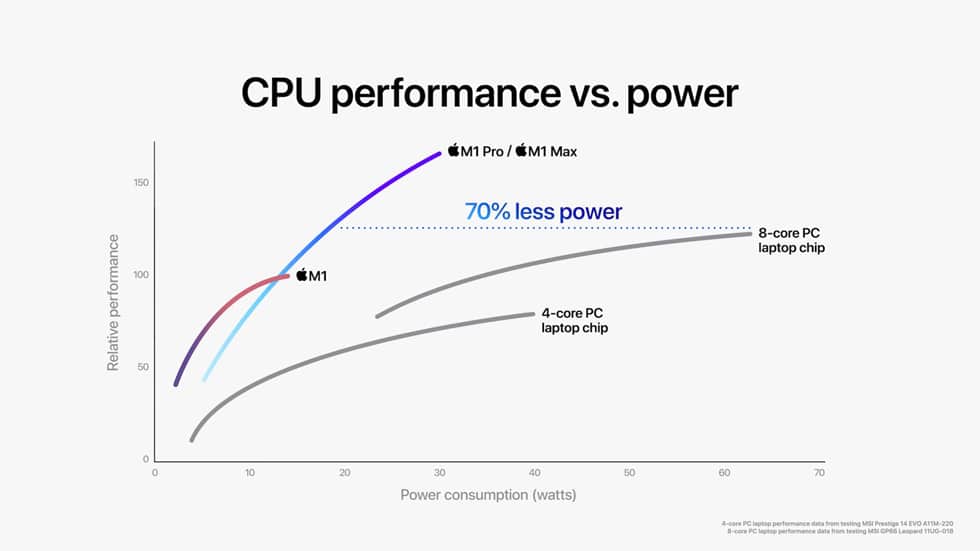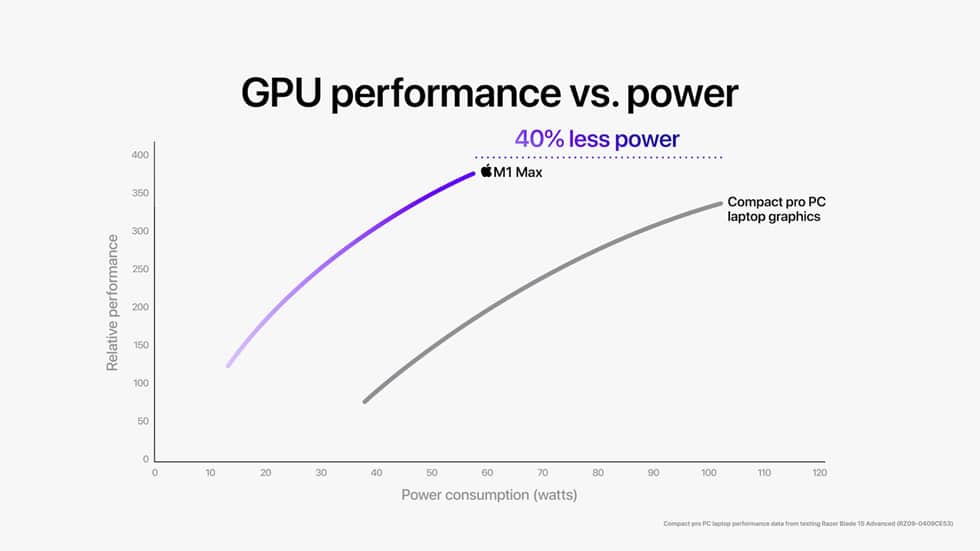According to Apple, M1 Pro and M1 Max are the most powerful chips that the company has ever built, delivering unprecedented performance and power efficiency. “Scaling up M1’s transformational architecture, M1 Pro offers amazing performance with industry-leading power efficiency, while M1 Max takes these capabilities to new heights,” Apple said in its press release on Monday. Let’s have a look at the specifications of M1 Pro and M1 Max: CPU Performance Vs. Power:
The M1 Pro chip includes up to 10-core CPU with eight high-performance cores and two low-performance cores. It delivers up to 1.7x more CPU performance at the same power level and achieves the PC chip’s peak performance using up to 70 percent less power. Further, the M1 Max chip features the same powerful 10-core CPU as M1 Pro. GPU Performance Vs. Power:
M1 Pro has an up-to-16-core GPU that is up to 2x faster than M1 and up to 7x faster than the integrated graphics on the latest 8-core PC laptop chip. Compared to a powerful discrete GPU for PC notebooks, M1 Pro delivers more performance while using up to 70 percent less power On the other hand, M1 Max adds a massive 32-core GPU for up to 4x faster graphics performance than M1. The 32-core GPU delivers performance comparable to a high-end GPU in a compact pro PC laptop while consuming up to 40 percent less power, and performance similar to that of the highest-end GPU in the largest PC laptops while using up to 100 watts less power. Memory Bandwidth: For the first time, Apple has introduced a system-on-a-chip (SoC) architecture through M1 Pro and M1 Max to pro systems. While M1 Pro offers up to 200GB/s of memory bandwidth with support for up to 32GB of unified memory inside of its 33.7 billion transistors, the M1 Max chip delivers up to 400GB/s of memory bandwidth, or nearly 6x the memory bandwidth of M1, and support for up to 64GB of unified memory inside of its 57 billion transistors. Efficient Media Engine With ProRes: M1 Pro and M1 Max also feature enhanced media engines with dedicated ProRes accelerators specifically for pro video processing while maximizing battery life. M1 Pro also includes dedicated acceleration for the ProRes professional video codec, allowing playback of multiple streams of high-quality 4K and 8K ProRes video while using very little power. On the other hand, M1 Max delivers up to 2x faster video encoding than M1 Pro, and features two ProRes accelerators. With M1 Max, the new MacBook Pro can transcode ProRes video in Compressor up to a remarkable 10x faster compared with the previous-generation 16-inch MacBook Pro. Neural Engine: Both M1 Pro and M1 comes with a 16-core Neural Engine that helps enhance machine learning capabilities on the new MacBook Pro models. “M1 has transformed our most popular systems with incredible performance, custom technologies, and industry-leading power efficiency. No one has ever applied a system-on-a-chip design to a pro system until today with M1 Pro and M1 Max,” said Johny Srouji, Apple’s Senior Vice President of Hardware Technologies. “With massive gains in CPU and GPU performance, up to six times the memory bandwidth, a new media engine with ProRes accelerators, and other advanced technologies, M1 Pro and M1 Max take Apple silicon even further, and are unlike anything else in a pro notebook.” Apple said that Mac is now one year into its two-year transition to Apple silicon, and M1 Pro and M1 Max represent another “huge step forward”.

